Hollywood roared back to life in southern Thailand with Jurassic World: Rebirth, released worldwide on 2 July 2025. Dinosaurs stormed through the raw, untamed beauty of Krabi, Phang-Nga, and Trang—Thailand’s fossil frontier and the film’s striking backdrop.
The dinosaurs may be digital, but the landscapes are 100% real. With dramatic coastlines, towering limestone peaks, and dense jungle, the filmmakers didn’t need to fabricate a setting—the terrain delivered it all.
Yet Thailand is more than a cinematic stage. It’s one of Southeast Asia’s richest palaeontological zones. Fossil sites in Khon Kaen, Kalasin, and Chaiyaphum have revealed remains over 100 million years old, including new species like Siamraptor suwati, a distant cousin of T. rex. Many of these discoveries are now on display in museums and open dig sites, reinforcing Thailand’s role as a regional hub for dinosaur research.
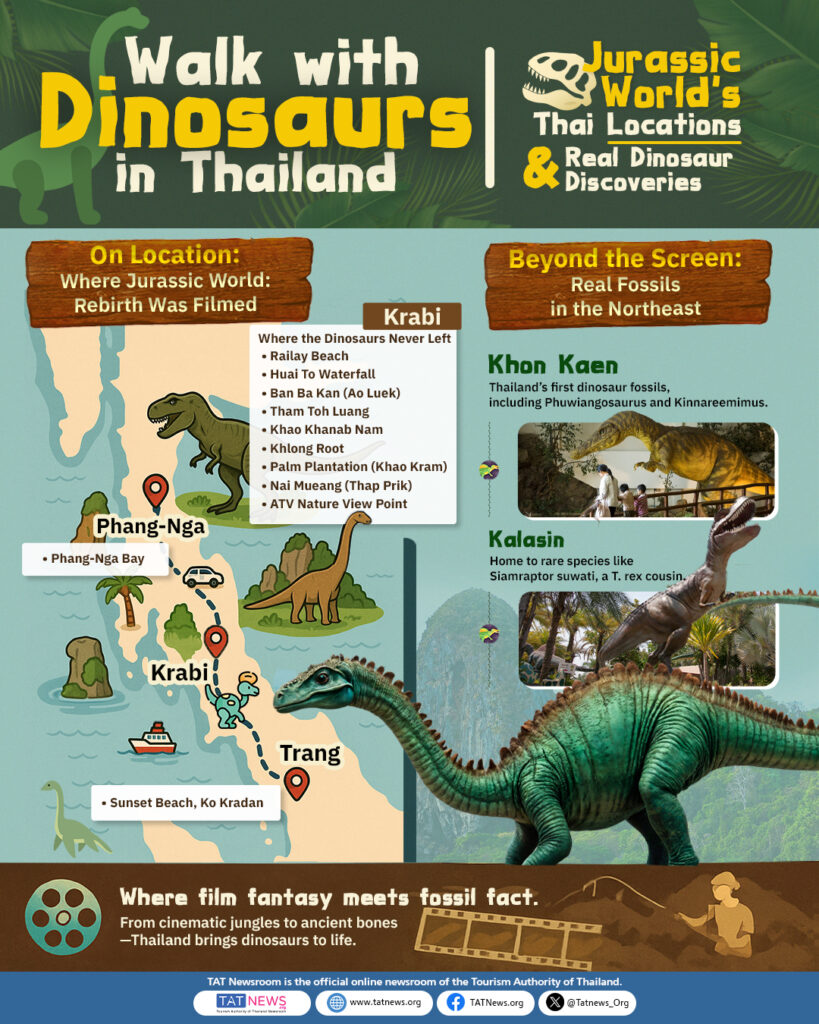
Film Locations: Where Jurassic World Comes to Life
Krabi – Where Dinosaurs Walked On and Off Screen
Krabi’s raw beauty—towering cliffs, rainforests, waterfalls, and caves—set the stage for Jurassic World: Rebirth. But it’s more than a movie set. Fossils found in Krabi’s Khlong Min Formation include Jurassic amber and a sauropod vertebra, making this lush province a true link between cinematic fantasy and ancient reality.
- Ban Ba Kan, Northern Ao Luek – This rugged, forest-covered area provided the perfect location for fast-paced jungle chase sequences, with its dense canopy and uneven terrain adding tension and realism to the action.
- Huai To Waterfall, Khao Phanom Bencha National Park – Towering over the forest floor, this multi-tiered waterfall set deep in lush jungle became the backdrop for key dramatic moments. The site blends natural grandeur with a sense of isolation that worked powerfully on screen.
- Khlong Root – Known for its spring-fed streams and crystal-clear waters weaving through tropical vegetation. This tranquil setting provided a visual contrast to the film’s more intense scenes.
- Railay Beach – Known worldwide for its vertical cliffs and turquoise waters, Railay Beach featured prominently in aerial shots, showcasing Krabi’s iconic karst landscape from above.
- Palm Plantation, Khao Kram – Used for expansive, open shots, this area of cultivated palms added a different texture to the film’s environment—wide, exposed, and filled with tension.
- Nai Mueang, Thap Prik – Remote and thickly vegetated, this lesser-known jungle zone was ideal for intimate, suspenseful scenes involving hidden dangers lurking in the foliage.
- Tham Toh Luang, Central Ao Luek – A series of limestone caves with eerie, winding chambers used in the film’s underground sequences. The caves’ natural acoustics and textures added authenticity to scenes of exploration and danger.
- Khao Khanab Nam – Twin limestone hills flanking the Krabi River like sentinels, these natural landmarks served as a visual gateway to the film’s version of the dinosaur world.
- ATV Nature View Point – Offering sweeping views over jungle valleys and peaks, this high point allowed for panoramic shots that captured the vastness of Krabi’s wild terrain.
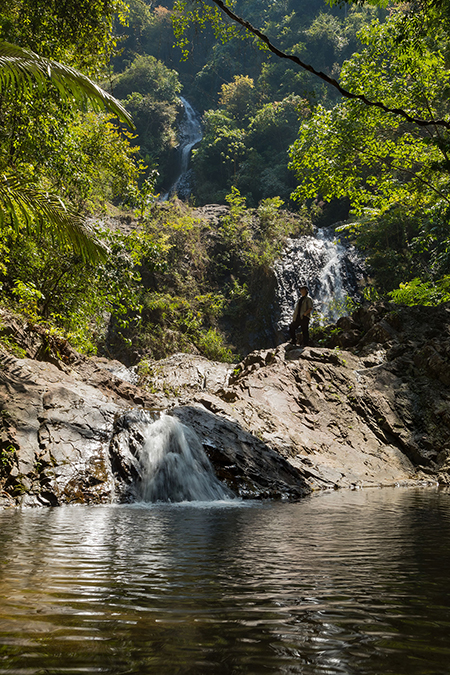
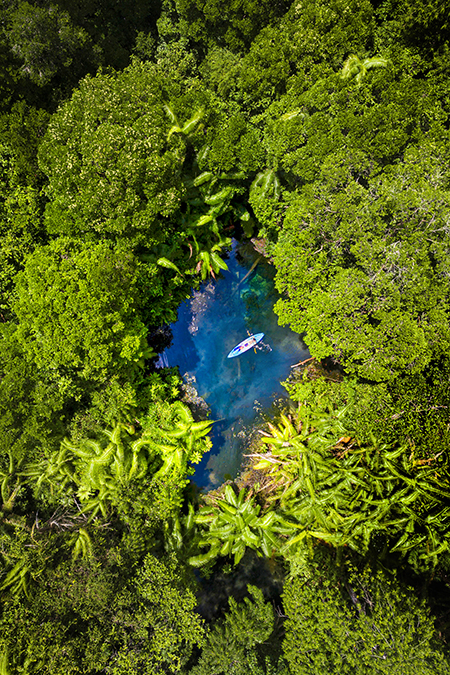
Getting there: Krabi International Airport has frequent connections from Bangkok. Filming sites can be reached by car or organised tour, with many clustered within national parks or coastal zones. Travellers can step directly into the cinematic world of Jurassic World: Rebirth—no green screen required.
Phang-Nga – Karst Islands and Coastal Majesty
Phang-Nga brought grandeur to Jurassic World: Rebirth, with limestone cliffs and emerald waters forming a natural backdrop for the film’s dinosaur-inhabited island world.
• Phang-Nga Bay – Seen in dramatic aerial shots, this iconic bay features over 40 limestone outcrops, sea caves, and lagoons—its prehistoric look needed virtually no digital enhancement.

Getting there: Just 1.5 hours’ drive from Krabi or Phuket. Day tours depart regularly from both provinces, with options for island-hopping, cave kayaking, and sightseeing cruises through the bay’s surreal landscape.
Trang – Remote Islands and Golden Light
Trang added a quieter, more secluded tone to Jurassic World: Rebirth, with unspoilt islands evoking a lost-world paradise filled with ancient mystery.
- Sunset Beach, Ko Kradan – With white sand, clear waters, and no roads, this remote island captured the look of a lost-world sanctuary. As the name suggests, the beach also offered golden-hour lighting that helped elevate key visual moments, naturally enhancing the cinematic quality without post-production filters.
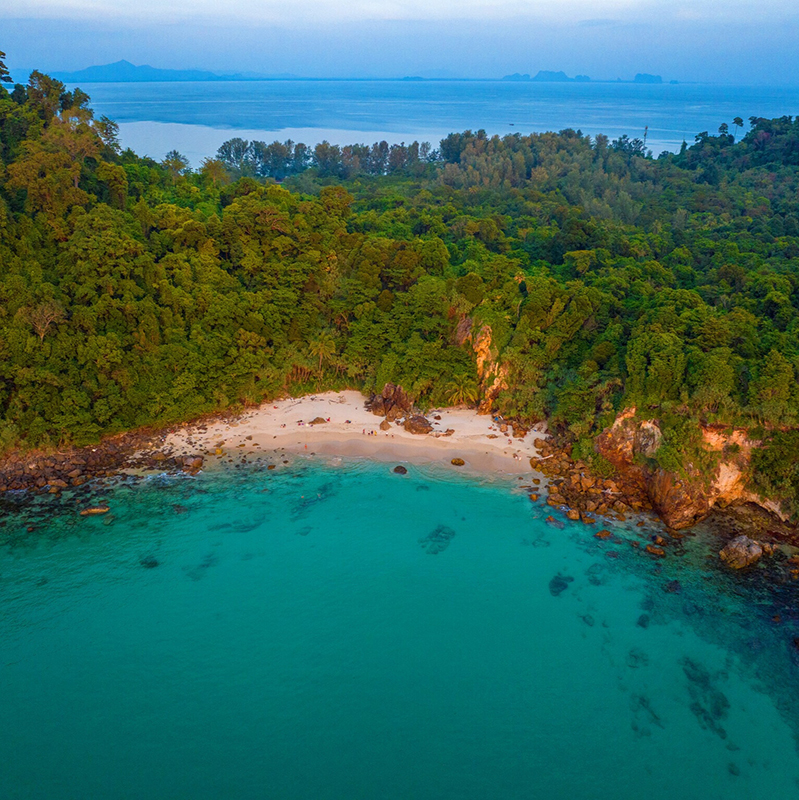
Getting there: Ko Kradan, part of Hat Chao Mai National Park, is accessible by boat from Trang town or Pak Meng Pier. Trang also has a domestic airport and serves as a gateway to southern Thailand’s quieter beaches.
Travel Tip: A Southern Thailand Itinerary Where Cinema Meets Nature
Krabi, Phang-Nga, and Trang are well connected and easily combined in one trip. Together, these three provinces offer a journey through cinematic landscapes and natural beauty—an ideal itinerary for travellers interested in film tourism, adventure, and southern Thailand’s unique ecology. Start in Krabi to explore jungle trails and waterfalls, then head north to Phang-Nga for island views and sea caves, before finishing in Trang, where peaceful islands bring the journey to a calm close.
Fossil Sites: Real Dinosaurs of Thailand
Long before they appeared in cinema, dinosaurs inhabited what is now Thailand. The Korat Plateau in the northeast is one of the region’s most significant fossil zones, offering discoveries that continue to reshape scientific understanding of prehistoric Asia.
Key Sites and Discoveries
Khon Kaen
Thailand’s first dinosaur fossil—a sauropod femur—was discovered in 1976 at Phu Wiang. Later finds include Phuwiangosaurus sirindhornae, a long-necked plant-eater named in honour of HRH Princess Maha Chakri Sirindhorn, and Kinnareemimus khonkaenensis, a bird-like dinosaur. Nearby Nam Phong has produced spinosaurid teeth and vertebrae dating back over 110 million years. These discoveries are showcased at the Phu Wiang Dinosaur Museum, located within the fossil-rich Phu Wiang National Park.
Getting there: Khon Kaen is served by flights, trains, and buses from Bangkok and other major Thai cities. The Phu Wiang Dinosaur Museum is about 80 km from Khon Kaen city and can be reached by car or guided tour.
Kalasin
A new tyrannosauroid species, a distant relative of T. rex, was uncovered here. The province is also home to key fossil exhibits of species discovered in the region and beyond—including Psittacosaurus sattayaraki, Siamosaurus suteethorni, and specimens of Phuwiangosaurus sirindhornae. The Sirindhorn Dinosaur Museum and the Phu Kum Khao Dinosaur Site, located in Sahatsakhan District, are major centres for research and public education.
Getting there: Kalasin is around 70 km east of Khon Kaen and is accessible by car or local bus. The Sirindhorn Dinosaur Museum and Phu Kum Khao Dinosaur Site are well signposted and easily reached from the town centre by road.
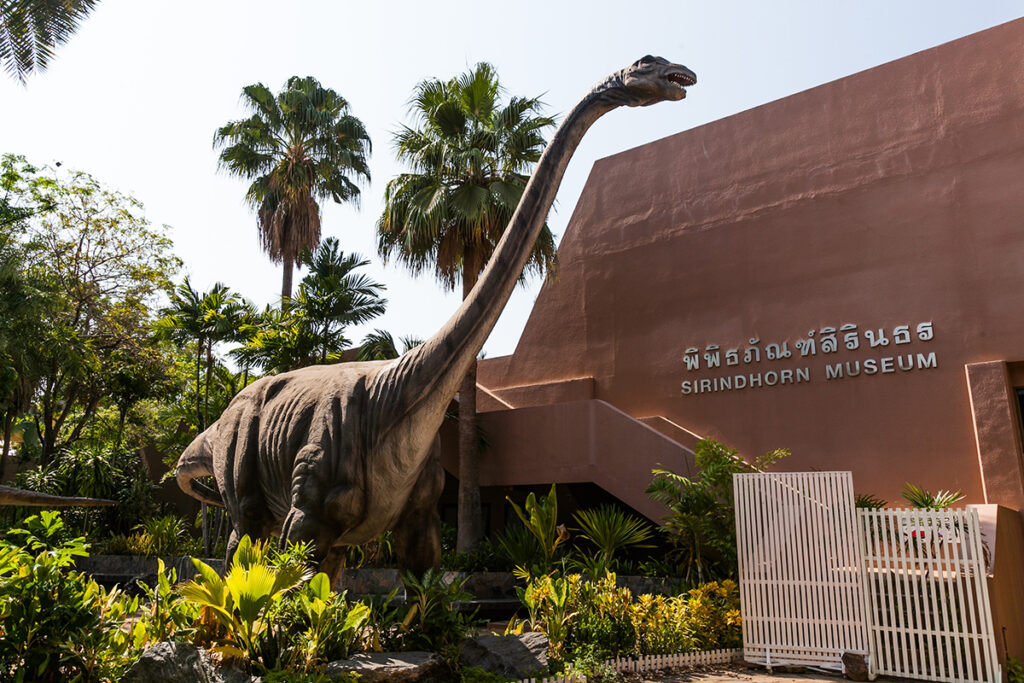

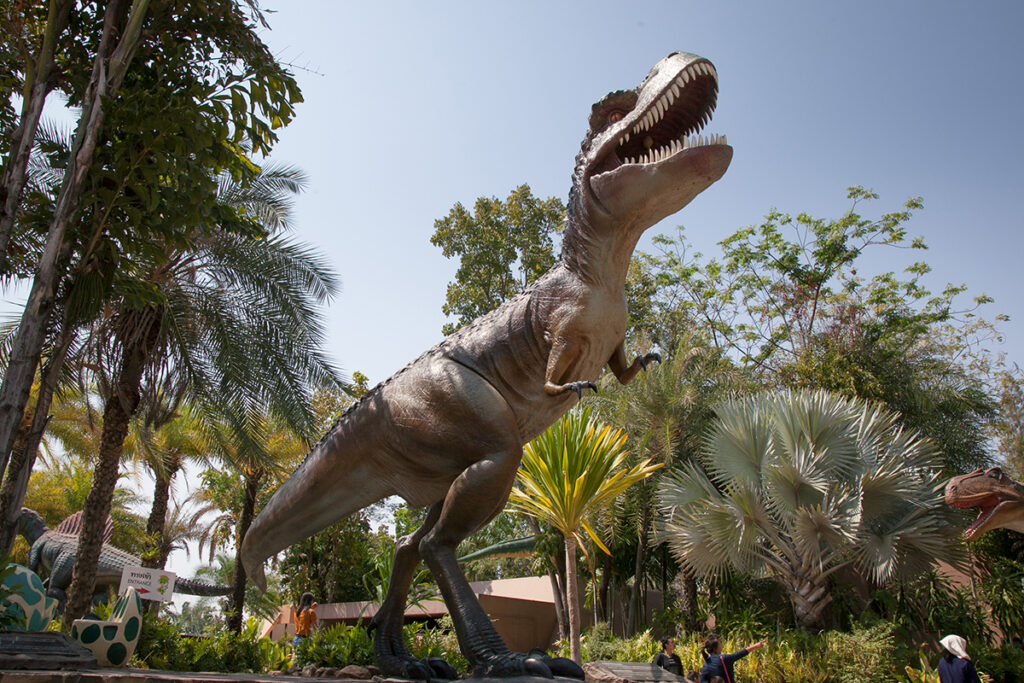
Travel Tip: Northeastern Fossil Route
These three provinces are all located on the Korat Plateau and form a compact, travel-friendly loop through Thailand’s dinosaur country. Starting in Khon Kaen, visitors can move east to Kalasin and then head southwest to Chaiyaphum, making it possible to explore all major fossil museums and dig sites in a single road trip or multi-day tour through northeast Thailand.
Additional Fossil Regions
While Khon Kaen and Kalasin lead the way, several other provinces also contribute to Thailand’s palaeontological record:
- Chaiyaphum – Part of the fossil-rich Khorat Plateau. While less prominent, the area continues to yield Mesozoic-era remains, including rare crocodilian fossils.
- Nakhon Ratchasima – Discoveries of sauropod bones and ancient turtles.
- Ubon Ratchathani – Fossils of large herbivorous dinosaurs, prehistoric fish, and crocodilians.
- Loei – Fossilised remains of fish and early reptiles.
- Nong Bua Lamphu – Dinosaur remains from the same basin as Phu Wiang.
- Phitsanulok – Rare northern site with crocodile and prehistoric animal fossils.
- Tak & Kamphaeng Phet – Fragmented teeth and bones under study.
Southern Fossil Finds
Although the northeast is Thailand’s fossil heartland, the south has also revealed important prehistoric remains:
- Krabi – A sauropod vertebra and Jurassic-era amber were unearthed in the Khlong Min Formation, Khlong Thom District—marking southern Thailand’s first known dinosaur fossil. These finds provide valuable insight into the region’s ancient ecosystems.
Why It Matters
Thailand’s fossil record is helping scientists reconstruct ancient ecosystems and understand dinosaur evolution in Southeast Asia. These discoveries have led to the naming of new species, public museums, and increased global interest in Thai palaeontology.
Discover Thailand’s real-life fossil sites and Jurassic film locations
Whether following in the footsteps of Hollywood or exploring real prehistoric ground, Thailand offers a journey unlike any other—from the cinematic cliffs of Krabi to the fossil-rich highlands of the northeast, where science and storytelling converge.


